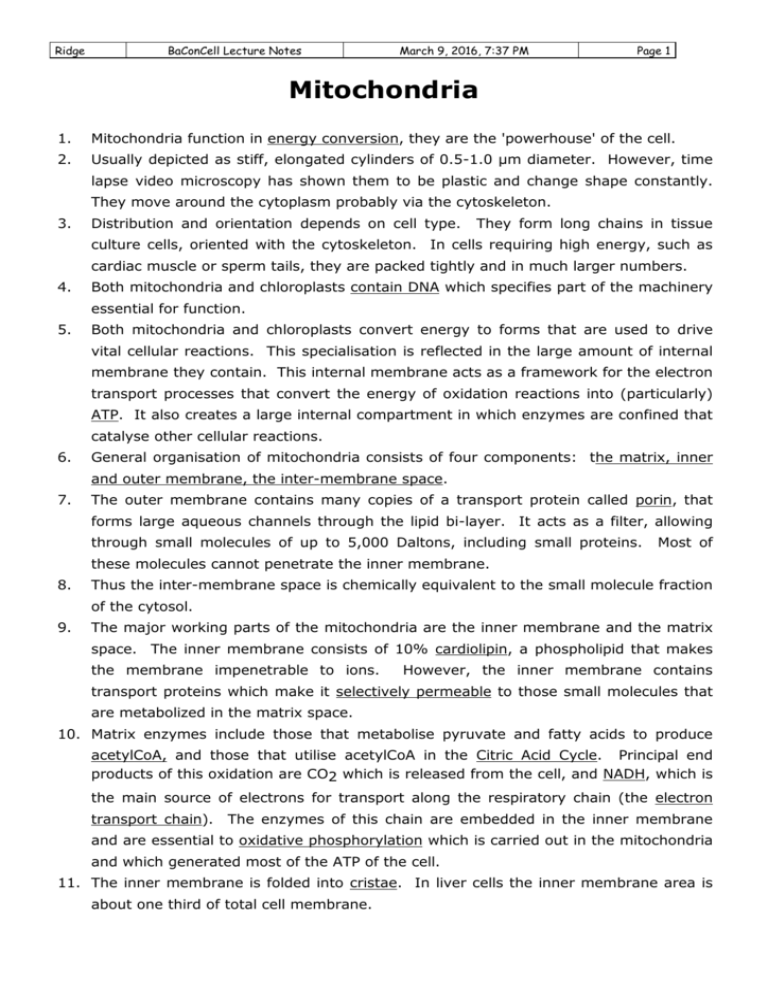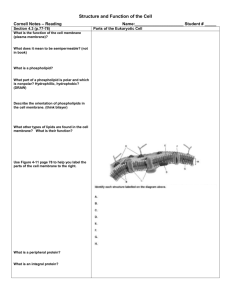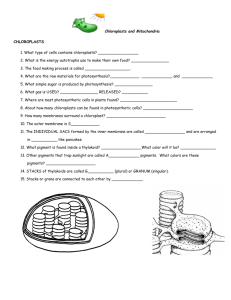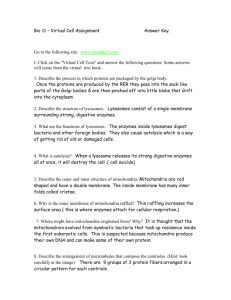lecture notes mitochondria
advertisement

Ridge BaConCell Lecture Notes March 9, 2016, 7:37 PM Page 1 Mitochondria 1. Mitochondria function in energy conversion, they are the 'powerhouse' of the cell. 2. Usually depicted as stiff, elongated cylinders of 0.5-1.0 µm diameter. However, time lapse video microscopy has shown them to be plastic and change shape constantly. They move around the cytoplasm probably via the cytoskeleton. 3. Distribution and orientation depends on cell type. They form long chains in tissue culture cells, oriented with the cytoskeleton. In cells requiring high energy, such as cardiac muscle or sperm tails, they are packed tightly and in much larger numbers. 4. Both mitochondria and chloroplasts contain DNA which specifies part of the machinery essential for function. 5. Both mitochondria and chloroplasts convert energy to forms that are used to drive vital cellular reactions. This specialisation is reflected in the large amount of internal membrane they contain. This internal membrane acts as a framework for the electron transport processes that convert the energy of oxidation reactions into (particularly) ATP. It also creates a large internal compartment in which enzymes are confined that catalyse other cellular reactions. 6. General organisation of mitochondria consists of four components: the matrix, inner and outer membrane, the inter-membrane space. 7. The outer membrane contains many copies of a transport protein called porin, that forms large aqueous channels through the lipid bi-layer. It acts as a filter, allowing through small molecules of up to 5,000 Daltons, including small proteins. Most of these molecules cannot penetrate the inner membrane. 8. Thus the inter-membrane space is chemically equivalent to the small molecule fraction of the cytosol. 9. The major working parts of the mitochondria are the inner membrane and the matrix space. The inner membrane consists of 10% cardiolipin, a phospholipid that makes the membrane impenetrable to ions. However, the inner membrane contains transport proteins which make it selectively permeable to those small molecules that are metabolized in the matrix space. 10. Matrix enzymes include those that metabolise pyruvate and fatty acids to produce acetylCoA, and those that utilise acetylCoA in the Citric Acid Cycle. Principal end products of this oxidation are CO2 which is released from the cell, and NADH, which is the main source of electrons for transport along the respiratory chain (the electron transport chain). The enzymes of this chain are embedded in the inner membrane and are essential to oxidative phosphorylation which is carried out in the mitochondria and which generated most of the ATP of the cell. 11. The inner membrane is folded into cristae. In liver cells the inner membrane area is about one third of total cell membrane. Ridge BaConCell Lecture Notes March 9, 2016, 7:37 PM Page 2 12. In the cytosol, glucose is broken down by glycolysis to two molecules of pyruvate, which then enter the mitochondria. Fat molecules in the form of triglycerides are broken down to fatty acids and these move into the mitochondria. Both of these products are broken down into acetylCoA which is fed into the Citric Acid Cycle (CAC). The CAC extracts high energy electrons from acetylCoA, which are held by NADH and FADH2 and are passed on to the respiratory chain in the inner membrane. 13. In the inner membrane, a chemiosmotic process converts oxidation energy into ATP from ADP + Pi. 14. None of the reactions leading to the production of NADH and FADH2 makes direct use of O2. This is the function of the series of reactions that take place on the inner membrane. In these reactions, the electrons are combined with molecular oxygen. The energy thus released drives the conversion of ADP + Pi to ATP. This is called oxidative phosphorylation, which depends on the chemiosmotic process. 15. The high energy intermediates are replaced by a link between chemical and transport processes. As the high energy electrons are transported down the electron transport chain in the inner membrane, the energy released is used to pump protons across the inner membrane from the matrix into the inter-membrane space. This creates an electro-chemical gradient across the inner membrane, and the backflow of protons down the gradient drives the membrane bound ATP-synthase that catalyses the ADP + Pi to ATP reaction, and oxidative phosphorylation is complete. The ATP is released into the cytosol as an energy source for reactions there. 16. The proton gradient is also used to transport metabolites (such as fatty acids) into the matrix space. 17. There are two components to the electrochemical gradient, proton motive force due to electro-chemical gradient (membrane potential), and proton motive force due to H+ gradient (pH). The voltage gradient drives ADP to ATP conversion, while the pH gradient drives pyruvate and phosphate import. 18. The biogenesis of mitochondria. As cells divide, new cytoplasmic organelles must be generated to keep pace with division. This can be accomplished either de novo, or by existing organelles also dividing. The latter is how mitochondria and chloroplasts arise, they are never made de novo. Mitochondria and chloroplasts contain separate genetic systems that are required for replication. However, relatively few proteins are encoded by this organelle DNA, and most organelle proteins are encoded by nuclear DNA. In humans and many other organisms, these mitochondria are inherited from the maternal side only, because the sperm contains only one large mitochondrion in the tail that is not transmitted during fertilisation. About half of plant species have maternal inheritance of both mitochondria and chloroplasts.









